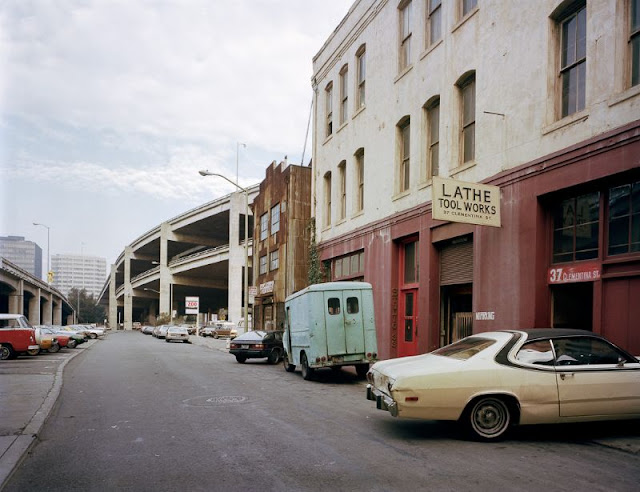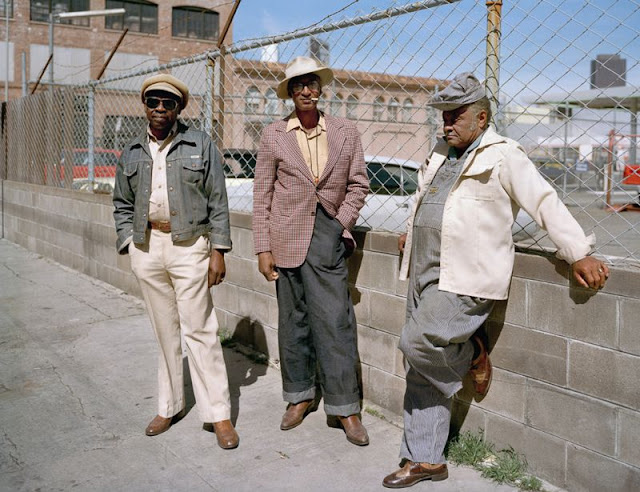Photos Show What Life of American Teenagers Looked Like in the 1980s
If you’ve tried to explain to a modern child the significance of a pencil to a cassette tape, and they don’t even have a clue what a cassette is, then welcome home.
Take a look at these photos from tshiverd to see what life of American teenagers looked like in the 1980s.

























Amazing Photos Capture Everyday Life of South of Market in the Early 1980s
SoMa is home to many of the city’s museums, to the headquarters of several major software and Internet companies, and to the Moscone Conference Center.
American photographer and educator Janet Delaney took these amazing photos to document everyday life of South of Market in the early 1980s.

|
| Chinese jumprope in front of Bessie Carmichael School, Folsom Street, 1980 |

|
| Hamburger Mary’s, 1582 Folsom at 12th Street, 1980 |

|
| Across from the Moscone Center, 3rd at Tehama Street, 1980 |

|
| Ambush Bar, 1351 Harrison, 1980 |
 |
| Bay Casket Company, 1020 Folsom Street, 1980 |

|
| Bulk Natural Foods, Russ at Howard Street, 1980 |
 |
| Eviction, 158-160 Langton Street, 1980 |
 |
| First office building in redevelopment zone, Lapu-Lapu St, 1980 |
 |
| Folsom at 8th Street, 1980 |
 |
| Giannini in his barbershop, established 1936, 484 6th Street, 1980 |

|
| Harry Smith, Bay Casket Company, 1020 Folsom Street, 1980 |

|
| Helen and her husband, Chester, at the Helen Cafe, 486 6th Street, 1980 |

|
| Langton Street residents Lalett and Vanessa Fernandez with their son, 1980 |

|
| Man with wheelbarrow, Moscone Center, 1980 |

|
| Mercantile Building, Mission and 3rd Streets, 1980 |
 |
| Moscone Center under construction, 1980 |

|
| Painting Mural, Langton Street, 1980 |
 |
| Pat serving coffee at the Gordon Cafe, 7th at Mission Street, 1980 |

|
| Policeman writing a ticket, Howard near 6th Street, 1980 |

|
| Project One Artists Studios, 10th at Howard Street, 1980 |
 |
| San Francisco Tennis Club Bar, 645 Sth Street, 1980 |

|
| School Demolition, 4th at Howard Street, 1980 |
 |
| Shantiben Dahyabhai Patel, Park Hotel, 1040 Folsom Street, 1980 |
 |
| Skip Wheeler and his wife groom their horses after Veteran’s Day Parade, Folsom at 2nd Street, 1980 |
 |
| Langton Park, Langton and Howard Streets, 1981 |
 |
| Lathe and Tool Works, 37 Clementina Street, 1981 |

|
| Longtime neighbors, Langton at Folsom Street, 1981 |

|
| Marie on Skates, Langton Street, 1981 |
 |
| Russ Street Apartments, 1981 |
 |
| San Bruno Statuary, 563 6th Street, 1981 |
 |
| San Francisco Ballet performing on opening days for the Moscone Center, 1981 |
 |
| Saturday afternoon, Howard between 3rd and 4th Streets, 1981 |

|
| Walt’s Diner, 7th at King Street, 1981 |
 |
| 10th at Folsom Street, 1982 |
 |
| Bobbie Washington and her daughter Ayana, 28 Langton Street, 1982 |
 |
| Carnary Island Diner, 1207 Harrison Street, 1982 |
 |
| Charging battery, Moss Street, 1982 |
 |
| Connie Hatch at the Canary Island Diner, 1207 Harrison Street, 1982 |
 |
| Flag Makers, Natoma at 3rd Street, 1982 |
 |
| Greyhound Bus Depot, 7th St. between Mission and Market Streets, 1982 |
 |
| Jean Decottignies, Jean’s Auto Body Specialists, 1264 Folsom Street, 1982 |
 |
| Labyris Auto Repair, “Complete Car Care By Women”, 240 6th Street, 1982 |
 |
| Ted Zouzounis and his son, David, at Ted’s Market, 1530 Howard Street,1982 |

|
| Transbay Terminal Newsstand, 1982 |
40 Vintage Pictures From Greenham Common Women’s Peace Camp in 1981 and 1982
On the 5th September 1981, the Welsh group “Women for Life on Earth” arrived on Greenham Common, Berkshire, England. They marched from Cardiff with the intention of challenging, by debate, the decision to site 96 Cruise nuclear missiles there. On arrival they delivered a letter to the Base Commander which among other things stated “We fear for the future of all our children and for the future of the living world which is the basis of all life.”
When their request for a debate was ignored they set up a Peace Camp just outside the fence surrounding RAF Greenham Common Airbase. They took the authorities by surprise and set the tone for a most audacious and lengthy protest that lasted 19years. Within 6 months the camp became known as the Women’s Peace Camp and gained recognition both nationally and internationally by drawing attention to the base with well publicized imaginative gatherings. This unique initiative threw a spotlight on ‘Cruise’ making it a national and international political issue throughout the 1980s and early ’90s.
The presence of women living outside an operational nuclear base 24 hours a day, brought a new perspective to the peace movement – giving it leadership and a continuous focus. At a time when the USA and the USSR were competing for nuclear superiority in Europe, the Women’s Peace Camp on Greenham Common was seen as an edifying influence. The commitment to non-violence and non-alignment gave the protest an authority that was difficult to dismiss – journalists from almost every corner of the globe found their way to the camp and reported on the happenings and events taking place there.
Living conditions were primitive. Living outside in all kinds of weather especially in the winter and rainy seasons was testing. Without electricity, telephone, running water etc, frequent evictions and vigilante attacks, life was difficult. In spite of the conditions women, from many parts of the UK and abroad, came to spend time at the camp to be part of the resistance to nuclear weapons. It was a case of giving up comfort for commitment.
The protest, committed to disrupting the exercises of the USAF, was highly effective. Nuclear convoys leaving the base to practice nuclear war, were blockaded, tracked to their practice area and disrupted. Taking non-violent direct action meant that women were arrested, taken to court and sent to prison.
The conduct and integrity of the protest mounted by the Women’s Peace Camp was instrumental in the decision to remove the Cruise Missiles from Greenham Common. Under the Intermediate Nuclear Forces (INF) Treaty, the missiles were flown back to the USA along with the USAF personnel in 91/92. The Treaty signed by the USA and the USSR in 1987, is in accord with the stated position held by women, in defence of their actions on arrest, when it states :
“Conscious that nuclear weapons would have devastating consequences for all mankind.”
A number of initiatives were made by women in Court testing the legality of nuclear weapons. Also, challenges to the conduct and stewardship of the Ministry of Defence as landlords of Greenham Common. In 1992 Lord Taylor, Lord Chief Justice, delivering the Richard Dimbleby
Lecture for the BBC, referring to the Bylaws case (won by Greenham women in the House of Lords in 1990) said “…it would be difficult to suggest a group whose cause and lifestyle were less likely to excite the sympathies and approval of five elderly judges. Yet it was five Law Lords who allowed the Appeal and held that the Minister had exceeded his powers in framing the byelaws so as to prevent access to common land.”
The Camp was brought to a close in 2000 to make way for the Commemorative and Historic Site on the land that housed the original Women’s Peace Camp at Yellow Gate Greenham Common between the years 1981 – 2000.













































































































